ZIP code 116xx | State New York Area code 917 | |
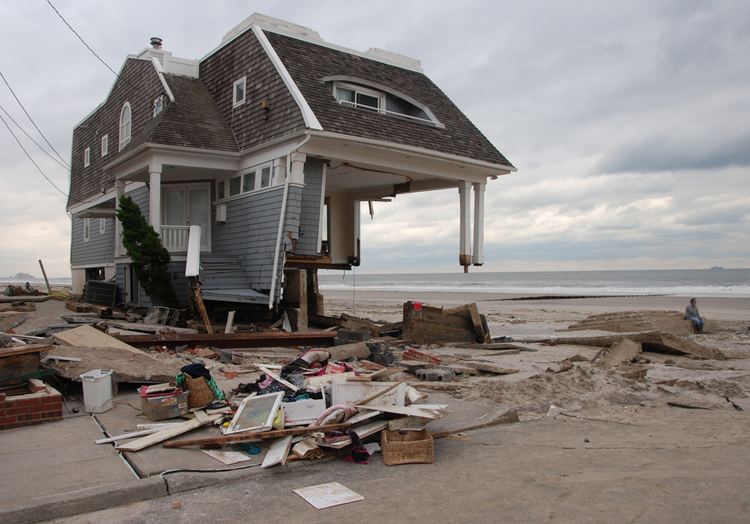 | ||
Named for Corruption of original Lenape language name | ||
The Rockaway Peninsula, commonly referred to as The Rockaways or Rockaway, is the name of a peninsula on Long Island, New York. The Rockaway Peninsula is located entirely within the New York City borough of Queens. A popular summer resort area since the 1830s, Rockaway has become a mixture of lower, middle, and upper-class neighborhoods. Its relative isolation from the urban areas of the city, especially Manhattan, has traditionally made it a popular summer retreat. In the 2010s, it became one of the city's most quickly gentrifying neighborhoods.
Contents
- Early history
- Early 20th century
- Robert Moses era
- Late 20th century
- Redevelopment
- Disasters and events
- Communities
- Education
- Public elementary and middle schools
- Public high schools
- Parochial and private schools
- Synagogues
- Libraries
- Transportation
- Trains
- Buses
- Ferry
- Culture
- Breezy Point
- Far Rockaway
- Rockaway Beach
- References
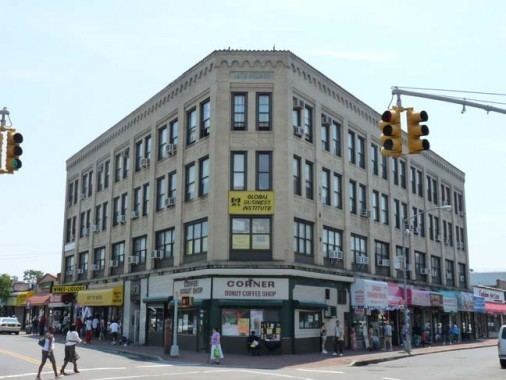
The neighborhood is part of Queens Community Board 14. As of January 1, 2007, the peninsula's total population is estimated to be just below 130,000. Rockaway is entirely in New York's 5th congressional district, represented by Congressman Gregory Meeks. All ZIP codes in Rockaway begin with the three digits 116 and the central post office is in Far Rockaway.
Early history
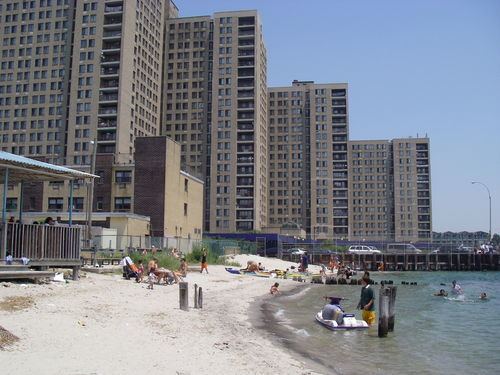
What is now known as Rockaway was inhabited by the Lenape Native Americans, but sold to the Dutch by the Mohegan tribe along with most of Long Island in 1639, and to the British in 1685. Finally the land was sold to Richard Cornell, who settled there. The name "rockaway" is the later corruption of a Lenape language word that sounded phonetically something like "rack-a-wak-e", and referred to the area. It may have meant "place of sands" (see: Toponymy of New Netherland and Metoac#Exonyms).
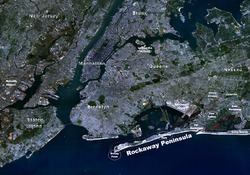
Rockaway became a popular area for seaside hotels starting in the 1830s, and its popularity grew with the coming of the Long Island Rail Road's Rockaway Beach Branch to Long Island City and Flatbush Terminal (now Atlantic Terminal), which facilitated population growth on the Rockaway Peninsula when it opened in the 1880s.
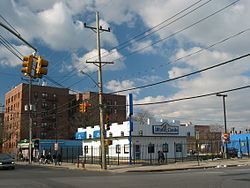
In 1878, the eastern community of Bayswater was laid out. One of Bayswater's early developers was William Trist Bailey, who had purchased the property.
In 1893, much of Hog Island, a small sandbar island off the coast of Far Rockaway washed away in a hurricane. The remainder of the island eroded away by 1902. Plates, along with older artifacts, still wash up along the shore of Rockaway Beach.
The Rockaway Peninsula was originally part of the Town of Hempstead, then a part of Queens County. In 1897, the central peninsular towns of Hammels (named after a local landowner, Louis Hammels) and Hollands merged, and were incorporated as the Village of Rockaway Beach. The entire borough of Queens was consolidated of Greater New York City in 1898. The village of Rockaway Park became incorporated into the City of Greater New York on January 1, 1898.
Early 20th century
In the early 1900s, the newly built railroad station opened up the community and the rest of the peninsula to a broad range of the population. The wealthy no longer had a monopoly on the peninsula, as various amusement parks, stores, and resort hotels attracted people from all over the city to spend a day or a whole summer there. Much of the area was developed by James S. Remsen and William Wainwright. In this era, it became known as "New York's Playground". Around this time, Breezy Point in the Rockaways began as summer beach bungalow; the bungalow became the most popular type of housing during the summer months. Even today, some of these remain, converted to provide modern amenities, although the vast majority were razed in urban renewal during the 1960s.
In 1900, a New York State judge ordered that the land west of Rockaway Park be put up for auction. Belle Harbor and adjacent Neponsit was bought by Edward P. Hatch, who sold it to the West Rockaway Land Company in 1907. The president of the company, Frederick J. Lancaster, who had earlier developed the Edgemere neighborhood, officially gave the community its name. Prior to Lancaster's acquisition of the land, however, a group of men wishing to form a yacht club entered into an grant agreement with the West Rockaway Land Company in 1905. The group, which had named itself the Belle Harbor Yacht Club, bought property from the company for four-thousand dollars. The agreement included two-hundred square feet of land and thirty plots of upland. That same year the group received corporation status by the State of New York and by 1908 began participating in its first inter-club ocean races with some of the city's other yacht clubs.
The central-peninsula neighborhood of Hammels, along with the eastern communities of Arverne and Far Rockaway, tried to secede from the city several times. In 1915 and 1917, a bill approving the secession passed in the legislature but was vetoed by the mayor at the time, John Purroy Mitchel.
Rockaway's famous amusement park, Rockaways' Playland, was built in 1901 and quickly became a major attraction for people around the region. With its growing popularity, concern over swimming etiquette became a problem and early in 1904, the Captain of the NYPD, Louis Kreuscher, issued rules for those using the beach, censoring the bathing suits to be worn, where photographs could be taken, and specifying that women in bathing suits were not allowed to leave the beachfront. The park was grand for its time. One of its most popular attractions, the Atom Smasher roller coaster, would be featured in the beginning of This is Cinerama, a pre-IMAX type movie, in 1952. An Olympic-size swimming pool and a million-dollar midway also were built within the amusement park; they would serve the community for over eighty years. It was a popular place for New York families until 1985 when insurance costs and competition from major regional parks made it impossible to continue operations.
Arverne became well known as a beachfront community with inexpensive summer bungalows, and hotels of varying levels of expense and luxury as well as amusements and boardwalk concessions, and it also attracted a year-round residential community. One grandiose plan for the community included a canal running through the neighborhood, reminiscent of the Amstel canal in Amsterdam, the Netherlands; however, the canal was not constructed and the canal right-of-way was converted into a thoroughfare, Amstel Boulevard, which, except for a stub west of Beach 71st Street, was later incorporated into Beach Channel Drive.
The first transatlantic flight departed from Neponsit on the Rockaway Peninsula. On May 8, 1919, four United States Navy-Curtis model seaplanes took off from what is now Beach Channel Drive in Neponsit to Newfoundland, Canada, the Azores Islands, and Lisbon, Portugal. Finally on May 31, 1919, only one plane, piloted by Lt. Commander Albert C. Read, arrived in Plymouth, England.
Robert Moses era
In the 1930s, Robert Moses came to power as New York City's Parks Commissioner and his extensive road and transportation projects were both a benefit and disaster for the neighborhood. As commissioner, Moses ordered the construction of the Marine Parkway Bridge and the Cross Bay Veterans Memorial Bridge. The bridges were completed in 1937 and 1939 respectively. The Marine Parkway Bridge was built further west on the peninsula between Jacob Riis Park and Breezy Point linking the isolated communities to Brooklyn. The Cross Bay Bridge landed in the middle of the neighborhood of Rockaway Beach. The construction of the two bridges started to transform the neighborhood and the rest of the peninsula into a more year-round residential area or commuter town, as people had a more convenient way to travel to and from work. The conversion of the Rockaway Beach LIRR branch to the Rockaway subway line also brought an increase to Rockaway's permanent residents.
Although the bridges were intended to improve the Rockaways, Moses' other projects both directly and indirectly hurt the community. One such failed project was the planned construction of the Shore Front Parkway in the 1950s and 1960s. Wanting to connect Staten Island to the Hamptons, Moses focused on making a highway through the Rockaway Peninsula. His idea was to connect the Marine Parkway Bridge with the Atlantic Beach Bridge, which connected the Rockaway Peninsula to Nassau County. The plan would also provide an extension midway through to include the Cross Bay Bridge. Many feared that such an extensive project would do more harm to the peninsula than good and pointed to the community displacement that had happened in the South Bronx because of Moses' roadway construction Even though Moses never got to make his highway, he did leave his mark. A piece of the planned parkway that ran west to east in the Rockaway Park and Rockaway Beach neighborhoods was constructed and opened in 1939. Houses were literally cut in half in order to build the four-lane street. Some of these houses are still standing today. The existing, still unfinished street is locally known as the "road from nowhere to nowhere" because it does not have any relevant connections to any other area or highway.
Robert Moses' construction of other recreational areas and facilities, such as the New York Aquarium and Jones Beach State Park, indirectly impacted the neighborhood as well. These more modern recreational facilities lured tourists and beachgoers away from the peninsula. With fewer customers, businesses and hotels closed, and by the 1950s, the area had fallen into economic decline. The transition from a summer vacationing area to a full-time residential neighborhood had taken its toll.
Late 20th century
In the years immediately following World War II, several public housing projects were built in the region, and these eventually became hotbeds of crime and related social pathologies. This provoked a backlash from some of the peninsula's more established residents (many of whom are of Irish Catholic heritage). A strong Jewish community (most of whose members are Ashkenazi Jews) also exists in the area around Far Rockaway. For example, the city constructed the Hammel Houses in Rockaway Beach. This project would be one of the many so-called urban renewal efforts that dominated the community and much of its eastern neighbors in the last half of the 20th century. The New York City Housing Authority purchased the land in 1952 on the north side of the elevated track. In 1964, the Authority decided to demolish and rebuild the entire area and turn it into a park.
With the advent of inexpensive travel, air-conditioning, John F. Kennedy International Airport, and the Interstate Highway system, Rockaway lost its luster as a recreation area, and development transformed much of it into residential communities
In 1960, Breezy Point was sold to the Atlantic Improvement State Corporation for $17 million in 1960; the residents of the 3,500-home community purchased half of the land for approximately $11 million and formed the Breezy Point Cooperative. The construction of apartment buildings commenced in the late 1960s and was halted by City ordinance. At the same time, much of the housing in the area was converted into year-round housing for low-income residents, and some of the bungalows were used as public housing.
Around the same time, the Arverne area was slated for a large redevelopment that never came; the area's redevelopment was cancelled after economic downturn in the 1990s. According to a 2003 New York Times article:
For nearly four decades, grand plans were offered for the 52-block stretch from Beach 32nd to 84th Streets, between Rockaway Beach Boulevard and the boardwalk. [There was to be] a phalanx of mid- and high-rise condominium and rental apartment buildings, [as well as] more than $1 billion... enclosed amusement area on the Arverne site, to be called Destination Technodome, with rides, movie theaters, an indoor ski slope and a hotel.
Until 1975, an additional fare was charged to passengers departing the IND Rockaway Line (A S trains of the New York City Subway) in any of the Rockaway-area stations, including Broad Channel, if the trip originated or terminated outside the area (in addition to the standard entry fare).
In 1982, New York City granted Broad Channel residents the right to purchase their property.
In 1998, Broad Channel's Labor Day parade received negative media attention after video of a float that parodied the racially motivated dragging death of an African American man, James Byrd, Jr., was made public. The float carried white men wearing blackface and Afro wigs, and was entitled "Black to the Future - Broad Channel in 2098". Three white participants on the float, two city firefighters and a city police officer, were later fired from their jobs as a result of the parade incident. They sued the city for wrongful termination, and had their claims upheld in federal district court in 2003. Local residents expressed support for and relief at the ruling, hoping that an end to the court battle would help to rehabilitate the image of the town. The United States Court of Appeals for the Second Circuit reversed the ruling in 2006, holding that the firings could stand.
Redevelopment
Redevelopment has started in some areas of the peninsula. Although various plans, including casinos, sports arenas, and other real-estate projects had been proposed in the past, many of these did not come to fruition due to either lack of funds, development stagnation, or resident resistance. However, in 2002, a "revival" began on the peninsula, as a new residential development plan started construction in a large vacant section between Rockaway Beach and Arverne. The new areas have become known as Arverne By the Sea and Arverne East. Far Rockaway Shopping Center, in downtown Far Rockaway between the [[Far Rockaway – Mott Avenue (IND Rockaway Line)|Far Rockaway A train subway station]], and the Far Rockaway LIRR station, got its first new store in decades, with others soon to follow as the run-down center was renovated. Then-Mayor Michael Bloomberg started to construct new housing and parks in Arverne-by-the-Sea, starting with 400 houses in Arverne. The Rockaways increasingly got attention and press as the redevelopment of the beachfront continued. Phase I of construction was completed in 2011; Phase II was begun in 2006. By 2012, Arverne-by-the-Sea was largely developed with some parts under new construction. The area now has new retail establishments, such as Stop and Shop Grocery Store, Chase bank branch, restaurants, and Subway sandwiches.
The piece of the Arverne-by-the-Sea development in Arverne is mostly complete. However, the section of the development west of Beach 59th Street, in nearby Edgemere, named "Arverne East", is still under construction. As of 2003, this 97 acres (39 ha) "Edgemere Urban Renewal Area" will have 400 houses built within it. Of these, 47 acres (19 ha) are houses, 35 acres (14 ha) is a nature preserve, and 15 acres (6.1 ha) is a segment of preserved dunes on the beach.
The new development projects, however, have sparked a new building boom in the neighboring communities. This has caused some concern and has led to various debates regarding development within those neighborhoods. The main problem has to do with Rockaway's zoning laws: those laws, decades old, cater to large multiple dwellings because of the hotels that had once existed in the area. This has led to construction of taller and wider buildings in areas that currently contain lower density housing. In response, some communities have approved rezoning plans for their neighborhoods in order to stop "out of character" development.
Opponents also contend that due to the rapidly growing population, the current infrastructure is inadequate and that there are environmental issues to consider. Those in favor of the development, however, contend that the development will help spur economic development and that the infrastructure cannot be upgraded until the population has reached a more noticeable level. Furthermore, some developers have questioned the legality of "down zoning". On August 14, 2008, however, a rezoning plan was approved by the New York City Council for five communities on the peninsula covering 280 blocks. The communities that were included are Rockaway Park, Rockaway Beach, Somerville, Edgemere, and Far Rockaway. The goal of the rezoning plan is to stop overdevelopment in these areas but at the same time allow growth within the context of the neighborhoods.
With more and more people moving to the city, the Rockaways become a destination for adventurous day trippers. The area appears in New York Magazine's 2007 spring travel issue as a place for "male bonding" and to "scuba dive for sunken ships" via Sheepshead Bay's Jeanne II docks at Pier Five. Today the area still draws crowds during the summer with well-tended beaches. Jacob Riis Park and Fort Tilden are situated towards the western end of the peninsula, and are part of the Gateway National Recreational Area, which was created in 1972 as one of the first urban national parks. The 5.5 miles (8.9 km) long Rockaway Boardwalk and 170 acres (0.69 km2) of sandy beaches, fully accessible by the subway, make this a popular summer day trip for New York City residents. Toward the western end of the boardwalk, several portions of the beach are fenced off to preserve the nesting habitat for several species of terns and plovers, making for a unique urban birdwatching locale.
After 2010, there was a major resurgence in the Rockaways' popularity. Various media began reporting on artists such as Andrew VanWyngarden, co-founder of popular psychedelic rock band MGMT, purchasing homes on the beach. The peninsula was dubbed "Williamsburg on the Rockaways", because some surfers from there spend whole summers out in the Rockaways. A number of businesses that cater to them, such as Rockaway Taco, become popular among these down for the day tourists. There is even a summer shuttle bus which transports people from Williamsburg to the Rockaways.
In February 2016, the Rockaways one of four neighborhoods featured in an article in The New York Times about "New York’s Next Hot Neighborhoods".
Disasters and events
On August 24, 1893, an intense storm, later classified as a hurricane, struck the area and caused Hog Island, a mile-long island off the Rockaway coast where a number of bath houses, restaurants and other leisure-time venues were located, to vanish.
On January 3, 1914, a violent storm devastated the peninsula, and completely swept the Arverne Pier Theater, which was capable of seating 1,200 people, away to sea.
On June 15, 1922, a large part of Arverne was leveled by a disastrous fire which left about 10,000 people homeless, although the neighborhood was quick to rebuild.
On June 6, 1993, a ship called the Golden Venture beached on the shore off Fort Tilden, located on the western half of the Rockaway Peninsula. The ship contained 296 Chinese illegal aliens including 13 crew members. Ten people drowned trying to reach the peninsula's shoreline.
Over 70 Rockaways residents were killed in the September 11 attacks on the World Trade Center in 2001, including people who worked there and New York City Fire Department firefighters and EMS personnel dispatched to the location. The city later opened a small park on Jamaica Bay north of the Beach 116th Street shopping area in Rockaway Park, calling it Tribute Park and dedicating it to the memory of those local residents who were killed on 9/11. On clear days, the park affords an excellent view of the skyscrapers of Lower Manhattan, the former site of the WTC. In the center of the park is a piece of twisted steel from the ruins of the trade center's Twin Towers. Solemn ceremonies are held at the park every Sep 11, including a reading of the names of all of the locals who perished on that day.
Almost exactly two months after 9/11, on November 12, 2001, American Airlines Flight 587 crashed in Belle Harbor, killing 265 people—260 on board the aircraft and five on the ground. Many of the passengers on the plane were from the Dominican community in Washington Heights. After consultation with the families in the Belle Harbor and Washington Heights communities, a memorial was erected at the south end of Beach 116th Street, a major shopping district and transportation hub in the area, accessible to all. Ceremonies commemorating the disaster are held at the memorial every Nov 12, including a reading of the names of all of those aboard the aircraft and on the ground killed in the crash. Although a temporary memorial was developed at the actual site of the disaster, on Newport Avenue, many still annually gravitate toward that area for commemoration. In 2001, a resident stated to The Guardian: "It's impossible to understand unless you live here ... Father Michael Geraghty, a priest quoted in the same article, said that it was common for people to live in the houses that their parents lived in and that many families lived in the same houses for generations. The neighborhood suffered heavy losses from the September 11, 2001, terrorist attacks." The impact of the 9/11 attacks and Flight 587 on the community was the subject of the book Braving the Waves: Rockaway Rises, and Rises Again by Kevin Boyle. The book contained many personal accounts of Rockaway residents and is liberally interspersed with historical interludes dealing with many times that the Rockaways have been devastated by fire and how its citizens and summer residents have met the adversity.
On April 5, 2011, Georgetown University medical student Jason Maloney landed a single-engine airplane carrying two passengers on the beach at Beach 56th St and Shore Front Parkway. After initially claiming he was required to make a forced landing due to a sick passenger, the pilot admitted he was inspired to perform a beach landing after watching the Discovery Channel show Flying Wild Alaska. The incident remains under investigation by the Federal Aviation Administration.
On September 8, 2012, the peninsula was struck by a tornado shortly before 11 a.m. that started as a waterspout over the Atlantic Ocean and came ashore at the Breezy Point Surf Club.
Rockaway was devastated by Hurricane Sandy in October 2012. Many homes in the Rockaways, especially in Breezy Point, were damaged or destroyed by high water, or by fires that raged beyond the capability of first responders to contain them. Residents lost everything in their basements, and hundreds of vehicles were ruined by the storm. One car caught fire when someone tried to start their vehicle, but residents put the fire out before help arrived. On August 4, 2013, Senator Charles Schumer announced that the first phase of reconstruction on the beach, completed, would lay the groundwork for a second contract awarded later during the summer of 2013, totally paid for by the federal government through the Hurricane Sandy relief bill.
During the storm, a fire, which spread between the closely spaced houses of Breezy Point while firefighters' access to the area was greatly hampered by flooding, destroyed 126 homes and damaged 22 more. Thousands of other houses were damaged by flooding. Fires also wreaked havoc along several blocks of Beach 130th Street in Belle Harbor, and among storefronts along Rockaway Beach Blvd. near Beach 114th Street in Rockaway Park. Large portions of the Rockaway boardwalk were swept away by the floodwaters, leaving only its supporting piers visible. The FDNY found 130 homes burned to the ground. Nearby, another 50 homes were damaged by the fire. According to an official report in December, rising seawater caused the fire by contacting a house's electrical wires. Besides the extensive human, physical and economic damage to the peninsula, the storm also struck a blow against local morale, as "Whalemina," a large, brightly colored statue of a smiling whale that had been a beloved iconic symbol of Rockaway since the 1990s, disappeared from her usual spot at Beach 94th Street near the Boardwalk and was presumed to have been swept out to sea.
Communities
Education
Like all areas of New York City, Rockaway is served by the New York City Department of Education.
Public elementary and middle schools
Public high schools
Parochial and private schools
Synagogues
Libraries
Queens Public Library operates several public libraries in the Rockaways.
A library is planned for the neighborhood, to be built by internationally known architectural firm Snøhetta.
Transportation
Rockaway is served by multiple transportation services.
Trains
The New York City Subway's IND Rockaway Line (A train), which has a terminal at Mott Avenue, passes through the eastern Rockaways. The A S trains, which ends at Rockaway Park – Beach 116th Street, serve the central Rockaways. The latter was the terminal of the former Rockaway Beach Branch of the Long Island Rail Road (LIRR).
The Far Rockaway terminal station for the LIRR's Far Rockaway Branch is located in Far Rockaway. The branch had originally been part of a loop that traveled along the existing route, continuing through the Rockaway Peninsula and heading on a trestle across Jamaica Bay through Queens where it reconnected with other branches. Frequent fires and maintenance problems led the LIRR to abandon the Queens portion of the route, which was acquired by the city to become the IND Rockaway Line.
Buses
MTA Regional Bus Operations routes include Q22, Q35, Q52, Q53, Q113, Q114, QM15, QM16, QM17, QM18, and Nassau Inter-County Express (NICE) routes include N31, N32, N33 in Far Rockaway only. Unlike other NICE routes in Queens, these buses operate open-door in Far Rockaway, meaning customers can ride these buses wholly within the neighborhood without necessarily going to Nassau County. NYC Beach Bus, a privately operated shuttle bus between downtown Brooklyn or Williamsburg and the area around Beach 84th Street and Jacob Riis Park, also runs in the area. One can also take a school bus named Rockabus from Williamsburg, Brooklyn.
Ferry
Ferry operator SeaStreak began running a city-subsidized ferry service between a makeshift ferry slip at Beach 108th Street and Beach Channel Drive in Rockaway Park, Queens and Pier 11/Wall Street, then continuing on to the East 34th Street Ferry Landing, after Hurricane Sandy in October 2012 destroyed much of the IND Rockaway Line. In August 2013, a stop was added at Brooklyn Army Terminal.
Originally intended as just a stopgap alternative transportation measure until subway service was restored to the Rockaways, the ferry proved to be popular with both commuters and tourists and was extended several times, as city officials evaluated the ridership numbers to determine whether to establish the service on a permanent basis. The fare was raised to $3.50 per ride during the extension period from $2 previously. Between its inception and December 2013, the service had carried close to 200,000 riders, city officials said.
When the city government announced its budget in late June 2014 for the upcoming fiscal year beginning July 1, the ferry only received a $2 million further appropriation, enough to temporarily extend it again through October, but did not receive the approximately $8 million appropriation needed to keep the service running for the full fiscal year. Local officials and community activists expressed dismay with the decision, saying it was a blow to the Rockaways as the area continues to struggle economically in the aftermath of the 2012 hurricane. A spokesperson for the city government's Economic Development Corporation said that “We will continue to examine ridership and seek a sustainable funding stream that can support the $25-$30 subsidy per trip — the highest by far of any public transportation in the city.” Efforts by local elected officials and community activists to convince the city government to reverse its decision and continue funding the ferry were unsuccessful, and it made its last trip on the night of October 31, 2014.
The Rockaways are expected to be served by the Citywide Ferry Service starting in 2017.
Culture
The Rockaway Arts Council provides a wide range of events throughout the year. Two art groups in Rockaway, the Rockaway Theater Company and the Rockaway Artists' Alliance, hold most of their productions in Fort Tilden.
Cultural references include:
Breezy Point
Far Rockaway
$tack Bundles also was a resident of redfern Houses a local celebrity in his own right beloved by the community
